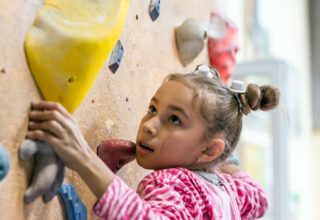Any opportunity for a fresh start to refocus and reset (the New Year, the start of the academic school year, the beginning of summer, etc.) is a grand time for setting ‘intentions’ for young children. Learn a lighter – yet deliberate – way of framing new beginnings, attitudes and choices with your child.
Learn
Intentions (vs. Resolutions)
‘Intentions’ are words or phrases you can use to capture the feelings you hope to experience when there is a fresh start. Intentions can be boiled down to a single word or simple phrase, so are highly memorable for young children.
By definition, the concept of an ‘intention’ is a commitment to grow every day and a reminder that mistakes may be made but there is opportunity to try again. Resolutions are more discrete; either an outcome is achieved or it is not. Intentions do not carry the same pressure or risk of failure as resolutions.
Engaging your family in setting intentions has several benefits:
- It empowers your child to feel ownership and accountability for their actions in the family.
- It equips everyone with a shared understanding of what is important as a family unit and to each individual member.
Do
Your Step-by-Step Guide
Setting intentions works best by creating space and time (time to think and talk). Different structures will work for different families and group settings. Here is one approach:
- Gather supplies – These should include a talking piece (an object that each person will hold when it’s their turn to speak), and any items that can be used to visually represent the intentions (e.g., paper, Post-it Notes, markers, tape, etc.)
- Introduce the concept – Gather the family and introduce the idea of setting intentions. “Today we’re going to spend some time talking about the past year and thinking about the New Year. What felt good this past year as a family? What were things we enjoyed doing? When were the times we laughed most?” Children may share examples of times spent together as a family or more individual thoughts; encourage both. Use the talking piece to move around the circle as many times as needed.
- Generate ideas – Ask everyone to think about the following year, “What do you want this year to feel like? To sound like? What would you like to see?” Engaging a child’s senses helps them focus on what may seem like an abstract process. Write their ideas down on a piece of paper.
- Guide the discussion to ‘intentions’ – Identify single words or phrases that capture the feelings each person hopes to experience. Make sure intentions are specific, and identify actions that will bring them to life. (e.g. “I’m going to focus on the must-do work in front of me and try to not be distracted by my running to-do list. I’ll stay at my desk until all my must-do work is done.”)
- If a child is having trouble identifying words around their intentions, guide them in a way that suggests the intention, but leaves the decision up to them (e.g. “It sounds like one of the things you want to feel in the New Year is peace with your brother. I wonder if taking deep belly breaths when you hear your voice getting louder when you’re disagreeing would help. What are other ideas you have?”
- Create visual reminders – Once everyone has shared one or two intentions, draw / scribble a visual reminder of each intention on a single piece of paper or Post-it Note. For example, if the intention is to “use helpful words instead of hurtful words,” the visual could be a talk bubble. Visual cues are highly successful for young children. Keep it simple. Tape the cues to eye-level, high-traffic areas (e.g., bathroom mirror, refrigerator door, bedroom door, etc.)
- Make it routine to reflect – Commit to a time as a family (either daily or weekly) when you will revisit the intentions and reflect on how you are doing (e.g., during breakfast or bedtime? On the walk to school? etc.
- Share your experience with your child when it comes to your own intentions – both when your intentions helped you and when you lost focus, and the steps you took to regroup. It is helpful for children to see grown-ups making an effort to identify the experiences and feelings we seek, and how we work to make them happen.
Bonus Activity
- For children: Use magic paper or dissolving paper to write intentions and then release them into the universe.
- For grown-ups: Write down your personal intentions and set everyday parenting habits with this printable.

Paige Abramson Hirsch, Teacher + Education Consultant + Parent
Paige Abramson Hirsch is an elementary school teacher turned lawyer turned educational administrator and educational consultant supporting school districts and charter schools. Paige studied psychology with a focus in child development at Tufts University and holds a JD/M.Ed from the University of Minnesota. Paige previously served on the Board of HAND, a non-profit for bereaved parents. She lives in San Carlos, California with her husband and two young children, whom she thanks for providing her with endless opportunities to analyze child development and behavior!
Let’s double-down on how to translate *growth mindset* into something tangible with your child. We’re focusing on how to teach...
*Yet* – Three letters that may change your child’s outlook on life, even among the youngest learners. Learn how the...
A simple tip sheet for how to praise your child. Something more than “Good job” or just commenting on process and...
Go beyond “How was your day?” Our Top 10 favorite conversation starters can give you insight into what matters to...
The benefits of mindfulness and how it can help your child thrive. How to naturally and authentically infuse mindfulness into...
Help your child to control their thoughts by making Mindful Minutes a routine. Your step-by-step guide on why, how and...
Learn at what age you should expect that your child can practice skills without prompting and strategies for encouraging your...
Teach your child to *THINK* before they speak – to consider the impact of their words (vs. their intent). A helpful...
When your child starts demonstrating behaviors that show they are trying to ‘fit in’ or wants to ‘belong to a...
Imagine a magical world where children are internally motivated to be kind and generous. It’s doable!
Acknowledge and promote positive behavior….*Plinkit* with a Marble Jar! You’ll be amazed at the twinkle in your child’s eye each...
Our Awesome Allowance System gives children practice in setting financial goals, making hard choices, and developing a sense for the...
We may have grand intentions when it comes to involving our kids in chores. But how do you know which...
Power struggles and harried mornings for both parent and child are normal, and yet not a fun way to start...
Help your child learn how to resolve a social conflict on their own with this framework – Wheel of Choices.
Empower your child with a valuable life skill – teach them how to express their emotions and desires during conflict.
















